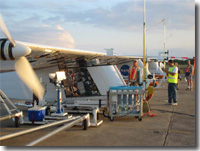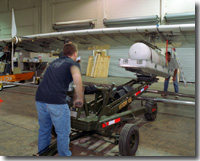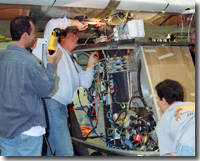HELIOS PROTOTYPE SET FOR LONG-ENDURANCE FLIGHT DEMONSTRATION
May 29, 2003
Release: 03-27
Printer Friendly Version

The solar-powered flying wing that set a world altitude record two years ago is poised for another milestone flight this summer – a long-endurance mission of almost two days and nights in the stratosphere.
This year’s mission for NASA’s Helios Prototype will be powered with high-efficiency solar arrays by day and a newly developed fuel cell-based electrical energy system at night. Developed by Helios’ manufacturer, AeroVironment, Inc., of Monrovia, Calif., the system combines advanced automotive fuel cell components with proprietary control technology designed for the harsh environment above 50,000 feet altitude.
The two-day endurance flight demonstration will be the crowning achievement in NASA’s 10-year Environmental Research Aircraft and Sensor Technology (ERAST) project, under which the Helios Prototype and several other remotely operated unmanned aerial vehicles (UAV) were developed. The ERAST project will conclude this September.
“The Helios Prototype has proven its capabilities to conquer the day on solar power,” said John Del Frate, Helios project manager at NASA’s Dryden Flight Research Center. “Now to fulfill the long-term vision for it to fly routinely for extreme duration, the next challenge is to conquer the night. The key to that is development of the fuel cell system. It’s the necessary next step to extreme endurance.”

Depending on technical and scheduling issues, the long-endurance demonstration flight could occur as early as mid-July from the U.S. Navy’s Pacific Missile Range Facility (PMRF) on the Hawaiian island of Kaua’i. A preliminary liftoff test May 15 on the PMRF runway showed the craft was stable despite the increased weight and load distribution of the fuel cell system. A 20-hour checkout flight to operate the system at altitudes above 50,000 feet is tentatively scheduled for early June.
Del Frate noted that the Helios Prototype will be the first large airplane to fly on fuel cell power, and the first to do so at night. The AeroVironment system consumes no fossil fuels, emits no atmospheric pollutants, and has a power-to-weight ratio about twice that of the best battery systems.
The fuel cell system being flight tested this summer combines gaseous hydrogen from two pressurized tanks mounted on Helios’ outboard wing sections with oxygen from the atmosphere. The hydrogen and oxygen are fed to a series of proton-exchange membrane fuel cell “stacks” mounted in the central landing gear pod. The system produces more than 15 kW of direct-current electricity to power Helios’ motors and operating systems, with the only by-product being water vapor and heat.
“The challenge is to operate the fuel cell system in a high-altitude flight environment,” said AeroVironment engineer Bill Parks, who led the development effort. “We had to learn a lot about operating in that environment. There were a number of tradeoffs, in terms of weight vs. efficiency, all of which were optimized for this (high-altitude flight) application.”

In August 2001, flying on electrical power generated solely by the 62,000 silicon solar cells mounted across the upper surface if its 247-foot long wing, Helios soared to an altitude of 96,863 feet, maintaining stable horizontal flight above 96,000 feet for more than 40 minutes. It was a world record for all winged aircraft except those powered by rockets.
Although the ERAST project will end this year, further development of the fuel cell system is likely to continue under a follow-on NASA project to perfect a regenerative version of the system.
“A mature non-regenerative system similar to the one we are flying this summer has the potential to fly continuously for two weeks in the stratosphere,” Del Frate explained. “It can give the Helios year-around global coverage, not limited to temperate or equatorial climes or latitudes.
“After testing on this system is finished this summer, we will focus on development of a fully regenerative system that could fly up to six months or more,” he added. Del Frate said a production version of the Helios with the regenerative fuel cell system is of interest to NASA for environmental science, the military and AeroVironment for various roles, primarily as a stratospheric telecommunications relay platform.
The latter role will be the focus of a flight demonstration planned for September at PMRF, in which the Helios Prototype will carry advanced broadband Internet connectivity and antenna systems developed by Japan’s Communication Research Laboratory and the Telecommunications Advancement Organization of the Japanese Ministry of Public Management, Home Affairs, Post and Telecommunications.
“These are payloads designed to be carried aboard a proposed high altitude stratospheric airship,” Del Frate explained. “We are providing a mechanism to test these technologies under operating conditions – flying slow, fairly stationary orbits at 65,000 feet altitude – conditions currently impossible for other aircraft.”
-nasa-
Note to Editors: Still photos and video footage of prior flights are available to support this release. Photos are available on the NASA Dryden Flight Research Center internet website at: /centers/dfrc/Gallery/Photo/Helios/index.html For photo prints or video dubs, please call (661) 276-2665.

























